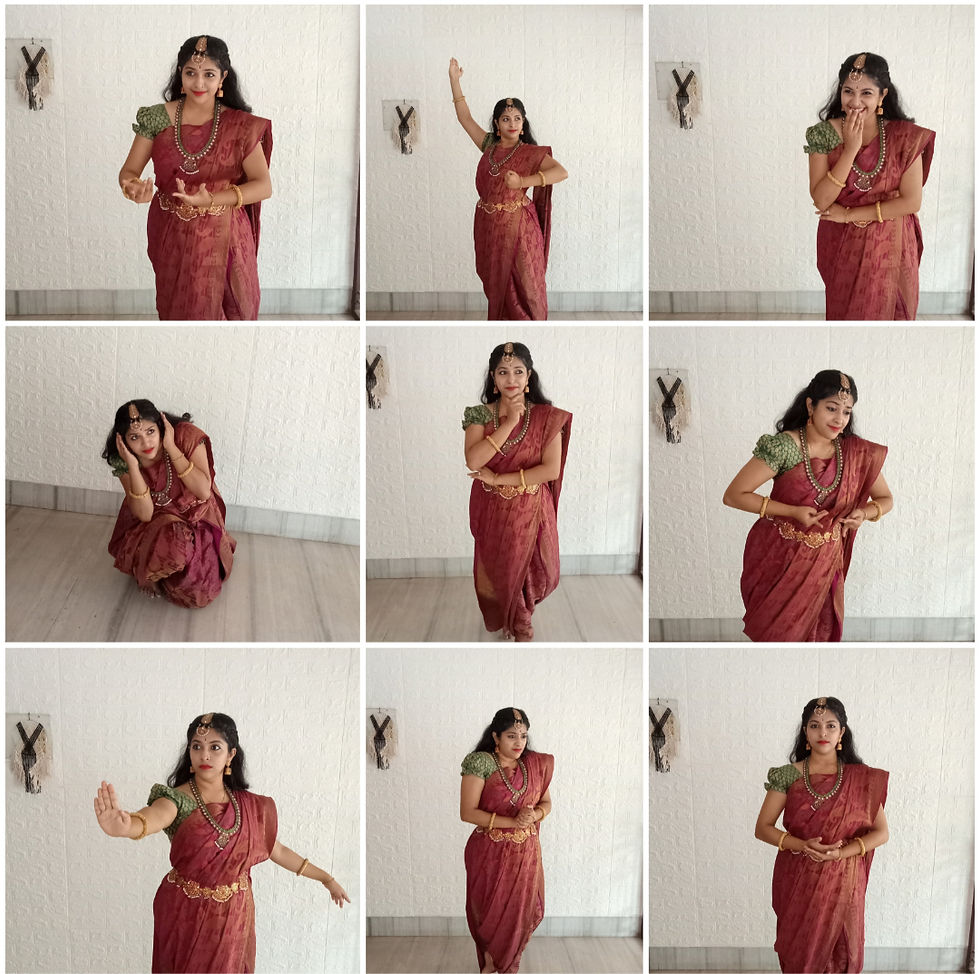UNDERSTANDING THE NINE RASAS : EMOTIONS IN BHARATHANATYAM
- Vajra Balaji

- Jul 31
- 3 min read
Bharatanatyam is far more than just beautiful movements and intricate footwork. At its very heart lies the profound art of abhinaya – the art of expression. And the soul of abhinaya is the concept of Nava Rasas, or the Nine Emotions.
The theoretical foundation for these profound emotional states can be traced back to Natya Shastra, an ancient Indian treatise on the performing arts, authored by the revered sage Bharata Muni. Dating back to between 200 BCE and 200 CE, the Natya Shastra is considered the oldest surviving text on dramaturgy and theatre in the world. It meticulously lays out the principles of dance, drama, and music, including a detailed exposition on how emotions (bhavas) lead to the experience of rasas (aesthetic flavors) in the audience. It is in this seminal work that the concept of Ashta Rasas (eight emotions) was first articulated, with the ninth, Shanta Rasa, gaining prominence in later traditions.

These nine fundamental human emotions are what a Bharatanatyam dancer masterfully conveys to the audience, transforming a performance from mere dance into a captivating storytelling experience. Understanding these rasas is key to truly appreciating the depth and nuance of this classical art form.
So, let's delve into the Nine Rasas:

The Navarasas: A Spectrum of Human Feeling
Each rasa is a distinct emotional flavor, brought to life through a combination of facial expressions (mukhabhinaya), hand gestures (hastamudras), body postures (angikabhinaya), and even the costume and setting (aharyabhinaya).
Shringara (Love/Beauty/Attraction)

Expression: This is perhaps the most celebrated rasa, encompassing all forms of love – romantic, filial, devotional, and even a sense of aesthetic beauty. It's often portrayed with gentle smiles, longing gazes, a graceful tilt of the head, and soft, flowing movements.
Keywords: Romance, beauty, affection, longing, joy.
Hasya (Laughter/Mirth/Comedy)

Expression: This rasa brings humor and lightheartedness. It's expressed through a broad smile, sparkling eyes, a chuckle, or even a hearty laugh. The movements are often playful and energetic.
Keywords: Laughter, joy, amusement, satire, cheerfulness.
Karuna (Sorrow/Compassion/Pathos)

Expression: Karuna evokes empathy and sadness. It's conveyed through downcast eyes, a trembling lip, tears, a drooping posture, and slow, melancholic movements. It can represent grief, pity, or distress.
Keywords: Sadness, pity, grief, empathy, compassion, tragedy.
Raudra (Anger/Fury)

Expression: This is the rasa of intense wrath. It's characterized by wide, glaring eyes, furrowed brows, flaring nostrils, clenched fists, and sharp, forceful movements. It can depict righteous indignation or destructive rage.
Keywords: Anger, rage, fury, indignation, destruction.
Veera (Heroism/Bravery/Valor)

Expression: Veera embodies courage, determination, and self-confidence. It's shown with an upright posture, steady gaze, a proud chest, and bold, expansive movements, often signifying strength and resolve in overcoming obstacles.
Keywords: Heroism, courage, bravery, determination, confidence, pride.
Bhayanaka (Fear/Terror)

Expression: This rasa communicates fear and apprehension. It's depicted with wide, darting eyes, a trembling body, shrinking movements, and a sense of vulnerability or panic.
Keywords: Fear, terror, anxiety, apprehension, helplessness.
Bibhatsa (Disgust/Aversion)

Expression: Bibhatsa conveys revulsion or repulsion. It's shown through a scrunched nose, narrowed eyes, a turning away of the face, and gestures that push something away or recoil from it.
Keywords: Disgust, aversion, repulsion, ugliness, revulsion.
Adbhuta (Wonder/Amazement)

Expression: Adbhuta captures a sense of awe, surprise, and wonder. It's expressed with wide, open eyes, raised eyebrows, an open mouth, and gestures that signify astonishment or marvel.
Keywords: Wonder, surprise, awe, amazement, curiosity.
Shanta (Peace/Tranquility)

Expression: This rasa represents serenity, calmness, and spiritual peace. It's conveyed through a relaxed posture, soft, half-closed eyes, a gentle smile, and very subtle, flowing movements, often indicating a state of inner harmony.
Keywords: Peace, tranquility, serenity, calm, detachment, spiritual bliss.
Why are Rasas Important?
The mastery of Navarasas is what elevates a Bharatanatyam dancer from a technician to an artist. It allows them to connect deeply with the audience, transporting them into the narrative and making them feel the emotions alongside the performer. When you watch a dancer beautifully portray Karuna, you feel their sorrow. When they express Hasya, you share their delight.
Next time you watch a Bharatanatyam performance, try to identify the rasas being conveyed. You'll find a whole new layer of appreciation for this incredible art form. The dancer isn't just moving; they are speaking directly to your soul through the universal language of emotion.




Comments